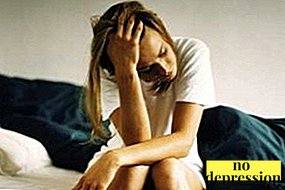Blue Devils is the most frequent complication of alcoholism.
Occurs on the background of a sharp cessation of drunkenness, expressed in various manifestations of psychosis.
The outcome depends on the severity of the symptoms and adequate treatment. Approximately every tenth alcoholic dies from Deryllia.
Concept definition

What is the delirium tremens called for? What is it and when comes?
Metallic psychosis (Deryllium) is called a mental disorder that occurs in alcoholics, who abruptly stop taking alcohol after a long binge.
Contrary to popular belief, delirium tremens does not begin during the period of libations and never intoxicated.
Patients rarely observed aggression. Usually they are friendly, eager to help others get rid of "the devils who bred everywhere." However, periods of good nature can dramatically change to negative and anger.
Also, patients are prone to suicide, some die as a result of the complete cessation of the functions of internal organs. The death rate is 10% of all cases and is associated with a lack of medical care.
Deryllium usually occurs at 2-3 stages of alcoholism after 5-7 years of regular libations. In women, delirium tremens develops much earlier, since the female body is less resistant to ethanol.
Syndrome classification
In medicine, the following classification of the syndrome is adopted:
- Typical view. It develops gradually and consistently, tracing the passage of certain stages.
- Lucid fever. Characteristically acute onset with impaired coordination, panic attacks, anxiety.
- Abortive flow Hallucinations have a fragmentary form, anxiety prevails. Often goes into other forms.
- Professional form. Begins, as a typical, then the patient is dominated by movements associated with professional activity.
- Mussitiruyuschaya form. It is manifested from other types, accompanied by severe vegetative disturbances, clouding of consciousness, and disorders of movements.
- Atypical course. It is a relapse of the disease. The patient has symptoms characteristic of schizophrenia.

The reasons
The main cause of delirium tremens is alcohol abuse for a long time. The basis of the pathogenesis is the intoxication of the body, which leads to a violation of metabolism in the brain.
TO factors that increase the likelihood of deryllium relate:
- long and frequent binges;
- the use of low-quality alcohol;
- the presence of diseases of internal organs;
- head injuries;
- the presence of mental illnesses, including family history;
- mental or physical stress.

Required condition for the appearance of delirium tremens is a sharp cessation of the intake of strong drinks after a long binge.
For example, a person stops drinking because of a deteriorating physical condition or injury. Very rarely, the disease is manifested in people who are not suffering from alcoholism, but who have taken a large dose of low-quality alcohol.
Symptoms
Usually, delirium begins 2-5 days after abrupt alcohol withdrawal. Harbingers arise even during the period of heavy hangover and are expressed in pains in the head, convulsions, speech disorders. In some cases, epileptic seizures may begin.
The psychosis proceeds continuously or several short attacks. Ends after 5-7 days, sometimes there is a sharp cessation after a long sleep.
5% of cases have a protracted course.. A characteristic feature is the complete lack of desire for alcohol and even aversion to it.
Also typical harbingers Deryllia are:
- nightmares ending in early awakening;
- insomnia;
- fatigue, weakness;
- depressed mood.

However, often the pro-normal period is absent. In patients The following symptoms develop dramatically:
- anxiety is replaced by euphoria and vice versa;
- anxiety, irritability, sensitivity to harsh sounds, bright light, smells;
- hallucinations, illusions;
- superficial sleep;
- crazy ideas;
- increased suggestibility.
All as one sick talk about the devils, aliens, fantastic animals, insects. The behavior of the patient is directly related to his hallucinations.
Some in a hurry collect things to get away from the "enemies", others, on the contrary, actively communicate with the "heroes" of their illusions. Man is as if out of time.
Hallucinations are the following types:
- Visuals. The patient sees different animals, spiders. It seems to him that he is being held, therefore he is trying in every possible way to escape from the trap.
- Hearing aids. A person hears voices, extraneous sounds. His voices are warned or threatened.
- Tactile. The patient feels that insects are crawling on him, he is bitten by snakes or animals. Any touch causes pain.

During hallucinations the patient dangerous for themselves and others.
He can jump out of the window, cause injuries to those nearby to get rid of the "attacker".
In the morning hours arise light gapsIn the evening, the person's condition worsens. The patient in this state is very inspired, it can be convinced that he sees non-existent objects, hears sounds and voices that are not there.
Memory losses appear periodically. The alcoholic does not remember either his name or what he said five minutes ago.
As the release of delirium tremens in patients observed mood swings. They then cry, then laugh. Hallucinations are well remembered, but they do not remember their condition and behavior.
Often a person can not care for themselves. Depression often develops, suicidal thoughts appear. Normalization of sleep is the first sign of improvement.
Often delirium accompanied and physiological disorders:
- tachycardia;
- pressure and temperature rise;
- respiratory depression;
- lack of coordination of movements;
- muscle weakness;
- paresis of the facial and eye muscles;
- increased sweating;
- trembling limbs;
- vomiting;
- epileptic seizures;
- incontinence, feces.
Effects
Deryllis has serious consequences for humans. The main complications are:
- Organic psychosyndrome. The patient has a symptomatic triad: memory loss, weakening of the intellect, a state of affect.
- Amnesia. It happens full or partial.
- Violation of the functions of internal organs.
- The deterioration of cognitive functions (memory, attention, thinking), even after leaving psychosis.
- Dehydration due to temperature rises to critical levels.
- Severe depression is usually characteristic of women.
- The state of hypomania is peculiar mainly to men.
- Paralysis and disability until the end of days.
- Suicide or severe injuries due to hallucinations.
- Fatal outcome due to malfunction of internal organs.
In the first case of death, death occurs in 15% of cases, with repeated attacks, the risk of death is doubled.

First aid
What to do when the "squirrel" comes, whom to call? At the first signs of the onset of delirium tremens should call an ambulance. The patient is subject to hospitalization in a drug or psychiatric clinic.
However, it is not always possible deliver the patient to the ward in a short time. In this case, he needs to provide all possible assistance at home.

Patients should be kept in bed until doctors arrive.
Sometimes worth it even tie a personso that he does not inflict injuries to himself and others.
It is necessary to give him a lot of fluid, to reduce intoxication. You can also give the patient a sedative or sleeping pill.
Self treatment of delirium tremens prohibited. This can lead to severe mental illness.
Treatment
Blue Devils Therapy begins with detoxification events. Patients are prescribed the following groups of drugs:
- Sodium chloride, glucose solution, saline.
They prevent dehydration, hypokalemia, help to remove the decay products of ethanol from the body.
- Vitamin-mineral complexes (B1, B6, S. PP).
- Mannitol solution to prevent swelling of the brain and lung.
- Hepatoprotectors (Essentiale, Essliver Forte) restore damaged liver cells.
- Soothing (Relanium, Dimedrol, Seduxen) relieve anxiety, normalize sleep.

Strong tranquilizers such as haloperidol is used in exceptional cases, if there is severe insomnia, severe anxiety, panic, agitation.
Also prescribed medications that reduce pressure, improve heart function.
All drugs are administered intravenously with droppersThus, a fast and pronounced therapeutic effect is achieved.
It is possible to withdraw from the acute state of a person in 10-15 days of active therapy. But for complete recovery requires a complete rejection of alcohol and long-term rehabilitation treatment for 2-3 years.
If the patient continues to consume alcohol, then the likelihood of the recurrence of psychosis increases dramatically. In this case, it takes much less time and much smaller dosages of strong drinks.
Prognosis and prevention
The outcome of treatment depends on the form of psychosis and the timeliness of therapy. Typical current has the most favorable outlook. Some patients still have impaired memory and pathology of internal organs.
The least favorable are muscling and professional Deryllium. Also, an unfavorable prognosis is observed if a person has organic symptoms: heart failure, kidney, liver, epileptic manifestations, muscle paresis, respiratory depression.

The main prevention of delirium tremens is refusal to drink alcohol.
But what to do if the patient had to urgently stop taking alcohol after a long binge.
It is possible to reduce the likelihood of dililia if get out of binge gradually. Also this should be done in the clinic under the supervision of doctors. Then the risk is generally minimal.
After that it is necessary to take all measures to get rid of alcohol addiction. This will help psychotherapy. Effective are coding techniques.
Deryllium is a dangerous consequence of long and abundant libations. "Squirrel" leads to the hardest consequences, including death.
You can avoid this if do not abuse strong drinks. If the binge has already happened, then it is necessary to leave it gradually, better under the supervision of doctors.
Blue Devils - causes, help, hospital treatment:



